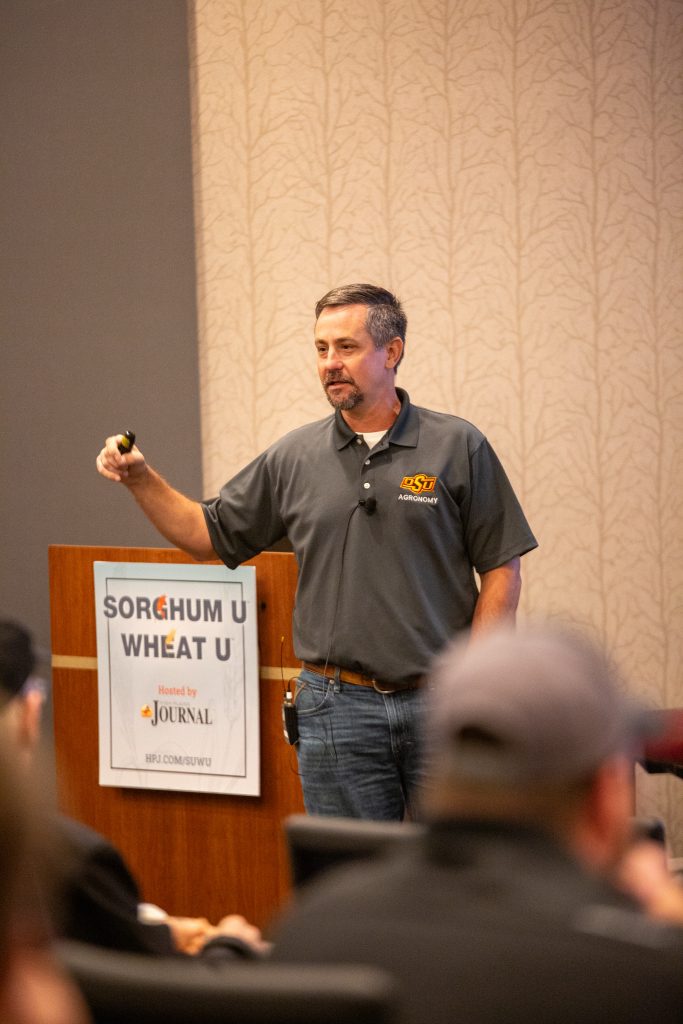Successfully growing a sorghum crop in the High Plains takes planning and a willingness to learn.
Brian Arnall, state Extension specialist with Oklahoma State University, said profitability should not be defined as a single season. Rather, his belief is that farmers have to focus on improving yield stability over just focusing on raising their yields, with the goal of being able to make a bad year better.
Arnall said that starts with managing soil health to ensure property fertility. The classic KISS acronym to “keep it simple, stupid” rule applies, he quipped.

Arnall was a featured presenter who addressed managing fertility to maximize profitability during the Aug. 13 Sorghum U/Wheat U event in Wichita, Kansas.
Arnall said while testing is important, it is important for growers not to become so obsessed with tests that they lose sight of value coming first.
“Soil tests can help you understand highs and lows,” he said, but a grower might want to identify zones in a field first and be consistent when taking samples.
“The key is to see how it trends over time,” Arnall said.
Using a grid process in a defined area can help determine the level of phosphorus and potassium in the soil but have the most value for variable rate lime.
Arnall touched on some common tests and benchmarks that growers use. He noted that if a soil pH is in a 5.7 to 6.2 range, it is a good benchmark to start. Arnall received questions about what to do when the pH is too low or too high.
When the pH falls below 5.5, he has seen stunted roots, and with grain sorghum plants that means poor water usage and nutrient uptake. The response by farmers is to add phosphorus or lime, which is a less expensive alternative, he said. Farmers need to keep in mind when applying minerals that the window of effectiveness can be narrow, he said.
Growers who have high pH levels are likely to face an expensive treatment process; however, the high pH can be managed with proper application of phosphorus, iron and zinc.
When asked about microbials, Arnall said he likes the concept of using microbes in soil health, but he told growers that if they choose that route, they need to consider it as a long-term approach.
“We’re just now understanding sulfur and nitrogen ratios,” he said. “Too much nitrate can change the effectiveness of sulfates.”
One finding was that the growing system can get out of balance, and when that occurs he suggests reducing nitrogen application and taking a look at phosphorous and potassium. In some fields, 6 to 8 inches of hard pan can prevent the sorghum root from breaking through, and that retards root development even if soil tests indicate sufficient levels of phosphorus and potassium.
Breaking through the hard pan takes several strategies, and for growers who have used no-till practices for many years, they may need to use a full-tillage operation at least once every 10 to 15 years, Arnall said.
He also does not recommend in-season application of phosphorus and potassium in dryland sorghum because of the variances in rainfall.
When it comes to pre-planting application of nitrogen, Arnall said it can be a good investment, and it generally is effective in an average year, but he also reminded producers that sorghum rarely has an average year, so they will need to weigh out yield potential and the cost of inputs.
He has found that delayed nitrogen application can be an effective strategy, and farmers may also want to consider starting with small test strips and then evaluating the results because that information could help them with future sorghum crops.
As a researcher, one reason Arnall likes to visit with producers is that they can provide insight into their operations, and he likes to share that with other growers.
“I want to give you a lot of scenarios, and you can experiment because you have a better playground than I do,” he quipped.
Dave Bergmeier can be reached at 620-227-1822 or [email protected].




